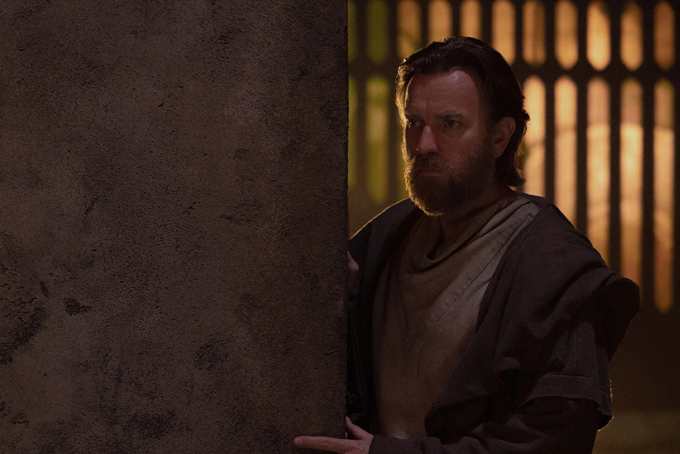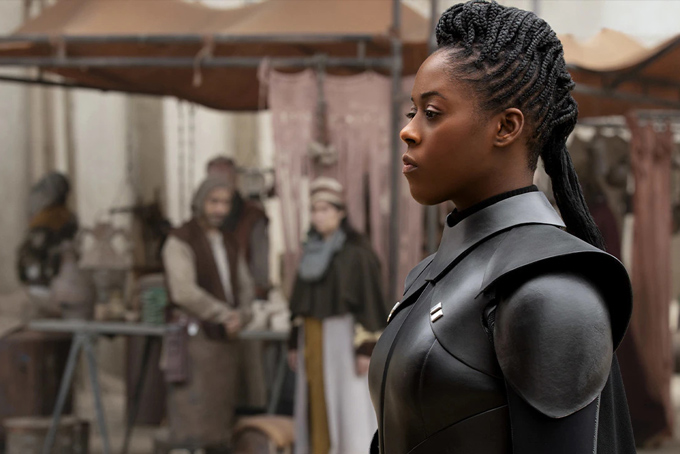“For 10 years, Obi-Wan has been in hiding. He can’t communicate with any of his old comrades, he’s living a pretty solitary life and he’s not able to use the Force. So, in a way, it’s like he’s lost his faith.,” says Ewan Mcgregor, as he contemplates what feels like lost time. And a lost space-time it has been, for the galactica’s fans who have been left to linger: sharing in the blitz of a frozen memory in time—almost 17 years ago, to be exact.
For the uninitiated, the Star Wars verse might seem a complicated one, but what remains seemingly consistent is how the Force simply doesn’t grow old for anyone. What first began as George Lucas’s envisioning of a fictional galaxy far, far away, evolved quickly into an epic series that took a shape of its own till this day. Post the initial three films of the 70s, much of the lore was free ground: from the animated series such as The Clone Wars and Rebels, the spin-offs á la The Mandalorian and The Book of Boba Fett, and of course, our unforgettable prequels (Episode I to Episode III).
View this post on Instagram
Naturally, the latter had been profoundly decisive in setting the stage for the upcoming Disney+ series Obi-Wan Kenobi, with McGregor and Hayden Christensen both returning to their pivotal roles of Obi-Wan and Darth Vader respectively. Being able to explore the complicated and redefined relationship between the two is critical to the core of the series, considering the near-undisputed fact that fans have long willed a narrative return of Obi-Wan. In the director Deborah Chow’s words herself: ”The history out of Episode III: Revenge of the Sith is so strong and powerful. We’re really looking at the character of Obi-Wan and going ‘What was important in his life? What are the relationships that were meaningful?’ And obviously, there’s so much weight coming into the story that’s connected to Anakin/Vader, so it felt natural that we would continue this relationship in the series.”
View this post on Instagram
Indeed returning to reminisce Episode III: Revenge of the Sith reminds all of a strange despair; it was the historic downfall of Anakin Skywalker, and the birth of Darth Vader. But what was truly felt by all, was the severed bond between Obi-Wan and his most-loved apprentice, his ‘Padawan’. It served a turning point indeed, and now 10 years later in the galactica, is where our characters return to. As revealed by McGregor, it ultimately feels like he’s playing a different version of his Obi-Wan, that’s just a bit closer to the version Alec Guinness had played in the original films.
Delving deeper with the cast, McGregor and Moses Ingram, as well as Chow, they share more about the much-anticipated narrative in the Star Wars universe: from developing their character arcs, the candid experiences on set together, and how it felt to fill in the gaps of the loved galaxy far, far away.

Ewan, there’s been talk for years about you wanting to return to Star Wars. What was it about this story specifically that really excited you?
It was a very long, slow process of coming back to playing him. For one, I was asked a lot if I were to ever play Obi-Wan Kenobi again. And so, I just started answering it honestly, and I think I became more aware of the fondness that the generation that we made the prequels for have for those films. So, that warmed my feelings about them, I guess, or my experience of being in the Star Wars world. The Star Wars fans are amazingly passionate and they’re probably some of the strongest fans in the world, you know, for anything. Disney just asked me to come in one day—and I said, yeah, I would love to play him again. I think there’s got to be a good story between Episode III and Episode IV and that’s what we definitely found, you know, after a lengthy process of exploring some different story lines. I think we’ve ended up with a really brilliant story and one that will satisfy the fans sitting between those two episodes.

Deborah, what did you want to explore most in Obi-Wan Kenobi’s character arc as well as the period in the timeline?
I think I was the most excited about getting the opportunity to do a character-focused story. Something like Joker or Logan where, you know, you take one character out of a big franchise and then you have the time to really go a lot deeper with the character. Obviously, we’re starting in a pretty dark time period and that was kind of interesting not only to start with Obi-Wan’s character in a dark place, but also starting in a period in the timeline that’s quite dark. But I think, you know, with the character of Kenobi, there’s always been so much warmth, so much compassion and humour, that it is kind of a character of light and hope. It was interesting for us to try to keep the balance of that, of the darkness, but also still maintaining the hope that comes from the character.
Moses, tell us a little bit more about Reva: who is this mysterious and dark Inquisitor and what were you most intrigued by?
She’s really smart in playing the offence and she’s always 10 steps ahead of you. As a subordinate to Darth Vader, she’s going to do everything she can to get the job done to the best of her ability. I would say I was most intrigued by her fervour for what she does.

This story takes place about 10 years after Episode III: Revenge of the Sith. Ewan, what makes this version sort of different compared to the screen adaptations we’ve seen before?
At the end of Episode III, the Jedi order are all but destroyed and those who aren’t killed have gone into hiding and they can’t communicate with one another. So, for 10 years, Obi-Wan has been in hiding. He can’t communicate with any of his old comrades and he’s living a pretty solitary life. He’s not able to use the Force. So, in a way, he’s lost his faith. It’s like somebody who’s stepped away from their religion, if you like And the only responsibility to his past life is looking over Luke Skywalker who he’s delivered to Uncle Owen and Aunt Beru. That’s his only sort of link to his past. With the work that I did in Episode I to Episode III—from the Padawan to the Jedi to somebody’s who’s sitting on the Jedi council—to take that Obi-Wan and bring him to this sort of broken place was something really interesting to do.
What was it like being on set with Hayden again?
I mean we just were so close when we met the first time: we made Episode II and III together and we made them in Australia. Over the years, we had slightly lost touch. I hadn’t seen Hayden for years. So when I saw him again and was able to talk about this project with him, it was very, very exciting. It was great. And when we were acting together, it was really like some sort of time warp. Looking across at him on set was like the last 17 years didn’t happen at all, you know? It was really peculiar.

The Volume technology that’s been used on The Mandalorian and The Book of Boba Fett was used for Obi-Wan as well. What was it like to use that technology to bring Tatooine to life?
Deborah: To be able to design, and develop material knowing that I was going to shoot using stagecraft was really exciting. A lot of times I’d be looking at the scene even as we were writing it, thinking about how this would translate into The Volume and how we could take advantage of the tech as best as possible.
Ewan: I’d never worked on the stagecraft set before and it was such a game-changer for us. The experience of the first three, especially Episode II and III—there was so much blue screen and green screen, and it was just hard to make something believable when there’s nothing there, you know? But here we were in this amazing set where, you know, if you’re shooting in the desert, everywhere you look is the desert. And if you’re flying through space, then, you know, the stars are flying past you as you scout along. It was so cool.
Obviously, the series is set inside a specific Star Wars timeline. Can you talk about the challenge of telling a story between these lines and also, how fun was it to get to fill in the blanks at the same time?
Deborah: Yeah, I would say that was definitely one of the biggest challenges with this series. Obviously, we have these huge legacy iconic characters and we’re in between two trilogies. So, in large part, you know, we’re telling the second act of a story which is often challenging enough. The biggest thing we were looking to do is to respect the canon and respect what’s been done, but we also needed to have an original story with an original vision. But bringing back two of these huge iconic characters and telling a new story with them, was overall really exciting.

How did your lightsaber experiences go? Ewan, did your old training come back to you?
Ewan: We started like, months before the shoot, together in the fight gym. And it was great. It was a nice way to get to know each other. We were under the great JoJo, our fight coordinator, who’s an amazing, thoughtful man. And he’d taken the fights that we did in the original three films and he sort of studied them with his crew, his stunt crew, before developing them. It was very thoughtful.
Moses: It was cool. We trained for about four months before we ever even got to the set. The everyday, regular strength and cardio, and then three days a week of Jedi school. We’re doing lightsaber work and of course, Ewan’s been doing this for years. So he’s like, flipping it and wielding it and I’m like, “Oh God, I’m never going to get it. I look terrible.” But you know, if at first you don’t succeed, try and try again.

Moses, was there anything that surprised you about joining this galaxy, or anything that you weren’t expecting?
I think this whole experience has far exceeded my expectations of what it might have been. I so enjoyed just going to work every day. I feel like we had such a great working atmosphere and there were so many lifelong Star Wars fans who were living their dreams by working on this series. And it’s really nice to be a fly on the wall, you know, for other people’s experiences of the thing as well. It’s by far exceeded my expectations in the most beautiful way.
Obi-Wan Kenobi airs on Disney+ on 27 May 2022.





